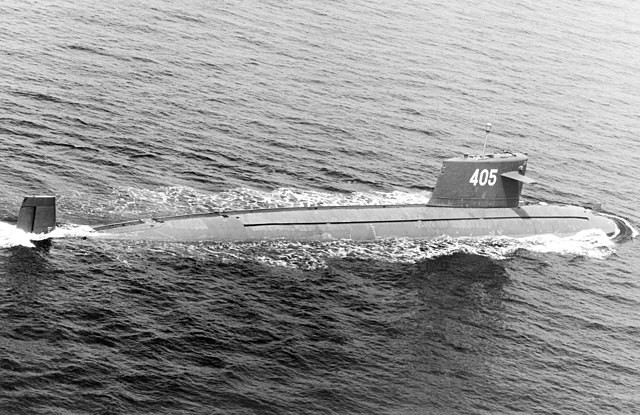China's ambitious naval expansion efforts have suffered a significant setback with the sinking of its newest nuclear-powered attack submarine, according to U.S. defense officials. Satellite images first noticed by Thomas Shugart, a senior fellow at the Center for a New American Security, brought the incident to light, despite Beijing's apparent efforts to keep it under wraps.
The Zhou-class submarine, China's first of its kind, reportedly sank while docked at the Wuchang shipyard near Wuhan between May and June of this year.
The loss of this state-of-the-art vessel represents a blow to China's strategic military aspirations, particularly as the country continues its rapid naval expansion to challenge U.S. dominance in the Indo-Pacific. The Zhou-class submarine, distinctive for its X-shaped stern designed for enhanced maneuverability, was seen as a critical asset in China's plans to develop a formidable nuclear-powered fleet. The sinking raises questions about the country's military infrastructure, transparency, and overall safety protocols.
Satellite imagery from Planet Labs PBC revealed the presence of floating cranes surrounding the submarine, indicating recovery efforts after the vessel submerged near the dock. The Zhou-class submarine was either fully or partially submerged when the images were taken on June 15. Further images from August showed a submarine back at the same dock, though it is unclear if it was the same vessel or a replacement.
More images of the Chinese Navy’s Newest Nuclear-Powered Attack Submarine (Zhou-Class, Type 041), That Sank at a Shipyard in Wuhan
US officials are unsure if the sub contained nuclear fuel at the time of the sinking, but it's highly likely.
The submarine was eventually salvaged… pic.twitter.com/C0pfkTWdQD — Indo-Pacific News - Geo-Politics & Defense (@IndoPac_Info) September 27, 2024
While there have been no reports of radiation leaks, the submarine's sinking has sparked concerns about whether it had been loaded with nuclear fuel at the time of the incident. China has not officially acknowledged the event, and a spokesperson from the Chinese Foreign Ministry offered no comment when questioned about the situation. "We are not familiar with the situation you mentioned," the spokesperson said at a press briefing in Beijing.
An unnamed U.S. defense official, speaking on condition of anonymity, confirmed that the submarine had sunk and emphasized the seriousness of the event. "It's not surprising that the PLA [People's Liberation Army] Navy would try to conceal the incident," the official said. "But the questions this raises about training standards, equipment quality, and internal accountability are significant."
Experts have weighed in on the potential impact of the loss. Brent Sadler, a senior research fellow at the Heritage Foundation, remarked that the incident would slow China's efforts to grow its nuclear submarine fleet. "The sinking of a new nuclear sub that was produced at a new yard will delay China's strategic plans in the region," he noted.
China's naval expansion, particularly its nuclear submarine program, is a key part of its broader strategy to assert maritime superiority, particularly in the South China Sea. The Pentagon's 2022 report on China's military capabilities notes that the country operates six nuclear-powered ballistic missile submarines, six nuclear-powered attack submarines, and 48 diesel-powered attack submarines. These numbers are expected to rise to 65 submarines by 2025 and 80 by 2035 as Beijing seeks to counter U.S. efforts to defend Taiwan and maintain dominance in the region.
The Zhou-class submarine was expected to be a crucial asset in this strategy, providing China with advanced nuclear attack capabilities to challenge U.S. presence in the Indo-Pacific. Its loss, therefore, presents a significant hurdle to Beijing's goal of achieving maritime military parity with the U.S.
The apparent attempt to cover up the incident raises further concerns about the transparency of China's military operations. "Can you imagine a U.S. nuclear submarine sinking in San Diego and the government covering it up? It would be unthinkable," Shugart remarked. The lack of official acknowledgment from the Chinese military underscores the opacity with which the country manages such sensitive issues.
China's efforts to keep the incident under wraps are reminiscent of its past behavior concerning military transparency and accountability. The People's Liberation Army has long been criticized for its secrecy, and the submarine incident may further erode international confidence in China's ability to manage its growing military forces responsibly.
The sinking of the Zhou-class submarine comes at a time of heightened geopolitical tensions in the Indo-Pacific. The United States, alongside allies like Australia and Japan, has been working to counter China's increasingly assertive actions in the region. The recent AUKUS partnership, involving the U.S., U.K., and Australia, aims to strengthen Australia's naval capabilities, including the acquisition of nuclear-powered submarines, to better deter China's military ambitions.
In response, China has accused AUKUS of provoking a nuclear arms race and disrupting regional peace. This latest setback with the Zhou-class submarine adds another layer of complexity to China's naval ambitions and the ongoing power struggle in the Indo-Pacific.






